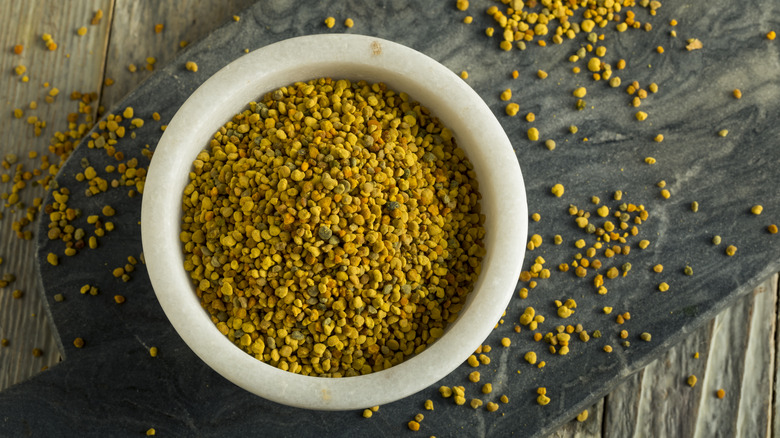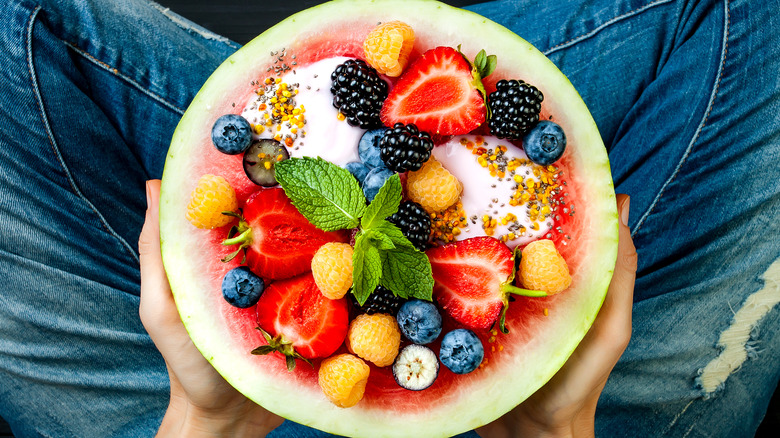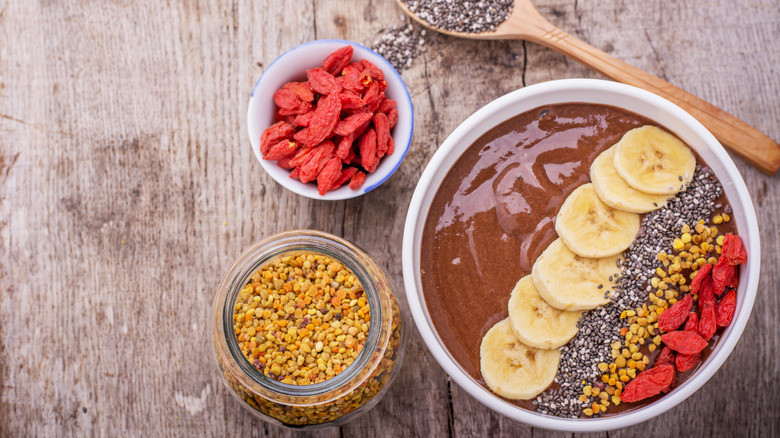Bee Pollen Is The Best Salad Topping For A Uniquely Sweet Crunch
Bee pollen is marketed as a dietary supplement, but you can also use it as a food ingredient. Its mild floral flavor will elevate your smoothie bowls, parfaits, and other homemade desserts, leaving you craving more. These tiny granules can also add crunch to salads while increasing their nutritional value. That's right — ambrosia, or bee pollen, contains all nine essential amino acids and significant amounts of protein, natural sugars, heart-healthy fats, and micronutrients, according to 2023 research published in the journal Antioxidants.
Touted as a "perfectly complete food," ambrosia is a nutritional powerhouse with antioxidant, anti-inflammatory, and anti-cancer properties. Despite its high sugar content, it may improve glycemic control and help prevent diabetes. Resveratrol, quercetin, and other antioxidants in bee pollen support cardiovascular function and liver health, and some compounds may protect against kidney damage. This superfood is also a good source of probiotics and may benefit gut health.
Like other bee products, pollen has a natural sweetness that complements sweet and savory dishes. Its unique aroma can turn a simple salad into a culinary delight and make your taste buds sizzle. All you need to do is sprinkle a teaspoon of pollen over leafy greens, beans, cheese, and other ingredients in your salad to appreciate its value.
Bee pollen can take your salad from good to great
This superfood boasts a subtly sweet and floral taste with hints of nuttiness. The flavor is not overpowering, making it ideal for lighter savory dishes. Bee pollen makes an excellent salad topping; you only need a small amount to reap the benefits. Start with a half teaspoon per day and go from there (the average adult can consume up to 5 tablespoons) depending on how your body reacts.
First, seek out a local beekeeper or other trusted supplier. Look for fresh, brightly colored pollen with no signs of spoilage or mold. Next, sprinkle 1 to 2 tablespoons on top of your salad just before serving to keep it crunchy and prevent it from getting soggy. Ideally, use it as a topping for salads made with hard cheeses, nuts, and veggies, especially spinach, kale, lettuce, endives, and onions. Generally, bee pollen isn't the best choice for mayo-based salads or those containing pickles, tomatoes, or fermented foods. Another option is to mix it into salad dressings, but it will lose its crunchiness. Apart from that, it's best to consume it raw and store it in the refrigerator or freezer.
Other delicious ways to use bee pollen
Bee pollen may be the key to building the perfect healthy salad, but that's just one of its many uses. You can also mix it into oatmeal, chia pudding, or acai bowls, stir it into coffee for a hint of sweetness, or add it to homemade ice cream and popsicles. To power up your day, swap your morning coffee for a smoothie made with bee pollen, berries, spirulina, and oranges. Another delicious option is to combine bee pollen, honey, and cinnamon and then use this mixture on toast, cookies, biscuits, or fresh fruits.
As a side note, some people may experience digestive discomfort, numbness, or tingling after eating bee pollen. For this reason, it's best to gradually increase your intake over time. To stay safe, take a break from it every month or so — and don't use it every single day. If you're on warfarin, get your doctor's approval before incorporating bee pollen into your diet. Also, beware that it's unclear whether or not this food is safe for pregnant and breastfeeding women.


